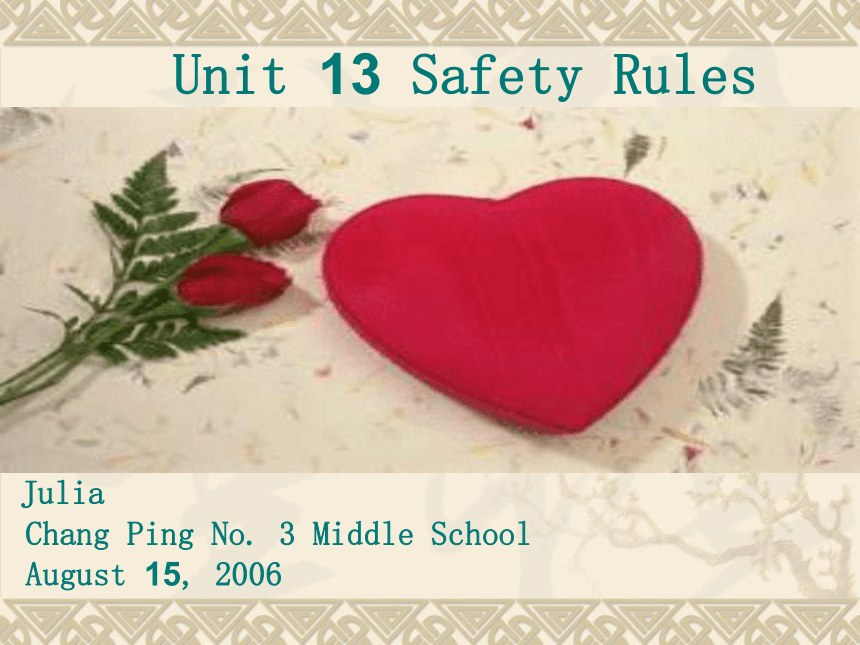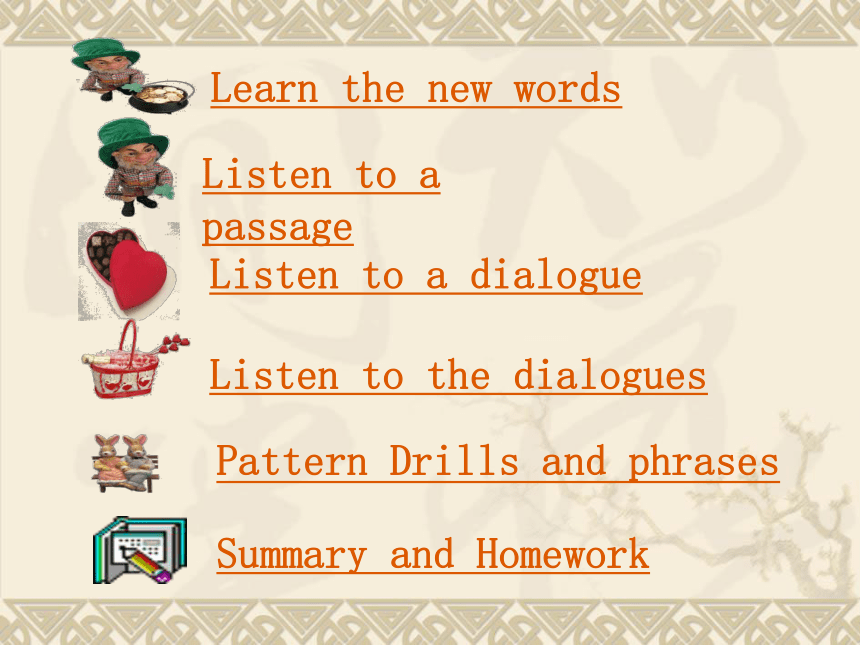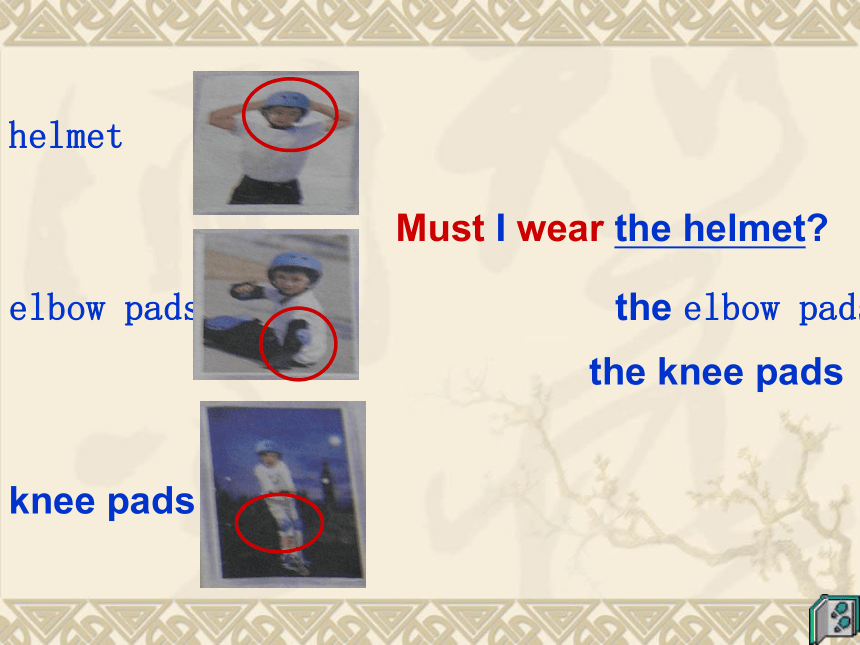英语:unit 13 safety rules课件(北京课改版八年级上)
文档属性
| 名称 | 英语:unit 13 safety rules课件(北京课改版八年级上) |  | |
| 格式 | rar | ||
| 文件大小 | 6.7MB | ||
| 资源类型 | 教案 | ||
| 版本资源 | 北京课改版 | ||
| 科目 | 英语 | ||
| 更新时间 | 2009-10-28 19:30:00 | ||
图片预览







文档简介
课件18张PPT。Unit 13 Safety Rules Julia
Chang Ping No. 3 Middle School
August 15, 2006Pattern Drills and phrases
Learn the new wordsListen to a passage
Listen to a dialogue
Listen to the dialoguesSummary and Homework smoke Can I smoke here? May I ride on the
sidewalk? sidewalk compassMust I take the
compass?helmetelbow padsknee padsMust I wear the helmet? the elbow pads
the knee pads The boy is going camping with his cousin.
The boy has to take all the thing with him.
The boy wants to do some fishing during the trip.
The boy can’t go fishing , but he can swim in a lake river.
The boy can return the day after tomorrow.
orTFA: May I ___________ in this area?
B: ____________. Look at that sign.
It says you mustn’t ride here. ride a bike No, you can’t Dialogue A
Can I smoke here? Dialogue C
A: Must I stay away from this box?
B: _________________.
When you see this sign, you
____________________________.Yes, you must. you must stay away from this box A: _______I ________________________with me?
B: No, you______. You ________________matches.
Pattern Drillstake this packet of matchestake this packet of matchesMaycan’tmustn’t play with A: _____ I ____________ near here?
B: No, you _______. You ____________________. play footballCan play football can’t mustn’t play football here A: ____ I ______________?
B: Yes, you _______. drink a littleMay drink a little
may The important phrases: on the sidewalk 在人行道
go camping with sb. 和某人去野营
want to do sth. 想做某事
do some fishing 钓鱼
during the trip 在旅途期间
go fishing 去钓鱼
the day after tomorrow 后天
stay away from… 远离……
a packet of matches 一包火柴
Summary and ExercisesMay I ……?
Can I ……?
Must I ……Yes, you may.
Yes, you can.
Yes, you must.
I am afraid you can’t.
No, you mustn’t.
No, you needn’t. Homework Listen and repeat about section 2,3,4.
Make similar dialogues according to the example.
Summary and Exercises 1.情态动词may表示“可以”,含有may的一般疑问句表示 请求、许可时,它的否定句回答不能用may not, 而是can’t 或mustn’t。我可以用你的电脑吗?
可以。
不,不能用。May I use your computer?
Yes,you may.
No, you can’t./No, you mustn’t. 2.情态动词must表示“应该”“必须”。否定形式 must not(mustn’t),表示“不应该”“不允许”“不准”等。本单元mustn’t的主要用法是表示禁止和警告。在回答must的问句时,肯定回答是Yes, you must.否定回答是 No, you need not (needn’t). 表示“不必”,而不用mustn’t。我现在必须走吗?
是的,你必须走。
不,你不必走。Must I go now?
Yes,you must.
No, you needn’t.
3.要求某人做某事时,可以用You must do sth. 或Remember to do sth. 例如:
你必须遵守交通规则。
记住在人行道上骑单脚滑行车。
You must obey the traffic rules.
Remember to ride your scooter on the sidewalk.
4.不允许某人做某事时,可以说You can’t do sth. 或 Don’t do sth. 。语气在强一点可以用 Never do sth.或者You mustn’t do sth. 例如:
你千万不要在河里游泳。
禁止在此处吸烟。
千万不要在迟到了。
千万不要把头、胳膊或叫伸出车窗外。
You must swim in the river.
You mustn’t smoke here.
Never be late again.
Never put your head, arms, or feet out of the bus windows.
Chang Ping No. 3 Middle School
August 15, 2006Pattern Drills and phrases
Learn the new wordsListen to a passage
Listen to a dialogue
Listen to the dialoguesSummary and Homework smoke Can I smoke here? May I ride on the
sidewalk? sidewalk compassMust I take the
compass?helmetelbow padsknee padsMust I wear the helmet? the elbow pads
the knee pads The boy is going camping with his cousin.
The boy has to take all the thing with him.
The boy wants to do some fishing during the trip.
The boy can’t go fishing , but he can swim in a lake river.
The boy can return the day after tomorrow.
orTFA: May I ___________ in this area?
B: ____________. Look at that sign.
It says you mustn’t ride here. ride a bike No, you can’t Dialogue A
Can I smoke here? Dialogue C
A: Must I stay away from this box?
B: _________________.
When you see this sign, you
____________________________.Yes, you must. you must stay away from this box A: _______I ________________________with me?
B: No, you______. You ________________matches.
Pattern Drillstake this packet of matchestake this packet of matchesMaycan’tmustn’t play with A: _____ I ____________ near here?
B: No, you _______. You ____________________. play footballCan play football can’t mustn’t play football here A: ____ I ______________?
B: Yes, you _______. drink a littleMay drink a little
may The important phrases: on the sidewalk 在人行道
go camping with sb. 和某人去野营
want to do sth. 想做某事
do some fishing 钓鱼
during the trip 在旅途期间
go fishing 去钓鱼
the day after tomorrow 后天
stay away from… 远离……
a packet of matches 一包火柴
Summary and ExercisesMay I ……?
Can I ……?
Must I ……Yes, you may.
Yes, you can.
Yes, you must.
I am afraid you can’t.
No, you mustn’t.
No, you needn’t. Homework Listen and repeat about section 2,3,4.
Make similar dialogues according to the example.
Summary and Exercises 1.情态动词may表示“可以”,含有may的一般疑问句表示 请求、许可时,它的否定句回答不能用may not, 而是can’t 或mustn’t。我可以用你的电脑吗?
可以。
不,不能用。May I use your computer?
Yes,you may.
No, you can’t./No, you mustn’t. 2.情态动词must表示“应该”“必须”。否定形式 must not(mustn’t),表示“不应该”“不允许”“不准”等。本单元mustn’t的主要用法是表示禁止和警告。在回答must的问句时,肯定回答是Yes, you must.否定回答是 No, you need not (needn’t). 表示“不必”,而不用mustn’t。我现在必须走吗?
是的,你必须走。
不,你不必走。Must I go now?
Yes,you must.
No, you needn’t.
3.要求某人做某事时,可以用You must do sth. 或Remember to do sth. 例如:
你必须遵守交通规则。
记住在人行道上骑单脚滑行车。
You must obey the traffic rules.
Remember to ride your scooter on the sidewalk.
4.不允许某人做某事时,可以说You can’t do sth. 或 Don’t do sth. 。语气在强一点可以用 Never do sth.或者You mustn’t do sth. 例如:
你千万不要在河里游泳。
禁止在此处吸烟。
千万不要在迟到了。
千万不要把头、胳膊或叫伸出车窗外。
You must swim in the river.
You mustn’t smoke here.
Never be late again.
Never put your head, arms, or feet out of the bus windows.
同课章节目录
- Unit 1 Vote for Bill
- Unit 2 My First Scoote
- Unit 3 What a Day!
- Unit 4 I’m Lost
- Unit 5 Advice Needed
- Unit 6 New Year’s Resolutions
- Unit 7 Revision One
- Unit 8 Cantonese Dumplings
- Unit 9 The Fire
- Unit 10 Amusement Park
- Unit 11 Sam’s First Job
- Unit 12 Famous People
- Unit 13 Safety Rules
- Unit 14 Revision Two
